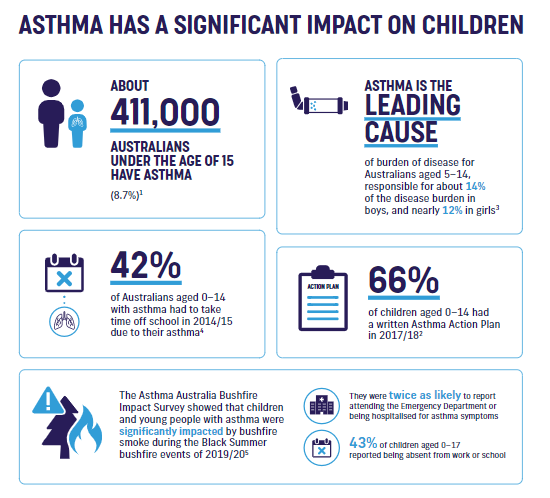New hat – check. New uniform – check. Water bottle – check. Spare asthma spacer and reliever – please check.
WHY DO ASTHMA FLARE-UPS HAPPEN AT THIS TIME?
Every year there is a sharp rise in the number of asthma attacks for kids when they return to school after the summer holidays. This results in more Emergency Department visits, hospitalisations and days off school. Not only is this unsettling for children as they try to kick-start a new year at school, but often it impacts on time off work for parents and carers. This can lead to work, time and money stress on the family.
Major factors include:
- with the loss of routine over the summer holidays and busyness of the Christmas period, sometimes preventer medicines are not taken daily as prescribed and written Asthma Action Plans are not followed as strictly
- the spread of viruses when kids return to school and mix with each other
- the possibility of new allergens at school not found in the home, or not come across for some time.

WHAT ROLE DO PARENTS AND CARERS PLAY?
You can help your child be prepared and have a healthy start to the new school year.
1. STAY ON TOP OF YOUR CHILD’S ASTHMA MANAGEMENT
To ensure your child is prepared for the return to school download our Back to School Asthma Adventure Game and following the steps below:
- Check your child’s medicines – Are they still in date? Do they require replacing?
- Keep vigilant with your child’s preventer medicine and ensure you give or they take preventer as prescribed, even when well – this is the mainstay of asthma management.
- If you haven’t already, see your doctor now for an Asthma Review to discuss recent asthma symptoms and control, medicine use, triggers over spring and summer and consider any allergies or environmental triggers that affect your child.
- Ask for an update to your child’s written Asthma Action Plan for everyday and school use.
- Ask your doctor or pharmacist to check your and your child’s inhaler technique face to face. This helps makes sure your child is getting the correct dose of medicine into their lungs.
- Recognise early signs of worsening asthma.
- Ensure anyone who is caring for your child has access to a copy of your child’s written Asthma Action Plan, medicines, spacer and mask (if needed) and knows how to use them and who to contact in an emergency.
- Understand your child’s triggers and take steps to avoid or manage them as discussed with their doctor and outlined on your child’s written Asthma Action Plan. Discuss your child’s allergies with your doctor if you are concerned.
- If exercise or playing sport is a trigger for your child, ask your doctor to include instructions on your child’s Asthma Action Plan on how to prevent and treat symptoms. Continue to monitor and manage allergies such as hay fever that can make asthma worse.
- Follow COVID-19 social distancing and hygiene advice.
- Stay up to date on weather conditions and be aware of high pollen or poor air quality days particularly over the summer bush fire season.
For more information watch the video below and visit our asthma in children page.
2. VISIT YOUR LOCAL PHARMACY
Visit a pharmacy before school commences to do the following:
- Purchase spare reliever medication, spacer, and mask (if required) ready for use at school – do you need more than one i.e. School office, Outside School Hours Care, Gym/Sports/Swim bag, the classroom emergency bag?
- If not completed with your doctor already – have you and your child undertake a face to face inhaler technique check with the pharmacist to ensure your child is getting the correct dose of medicine into the lung.
3. PLAN A TALK WITH YOUR CHILD’S TEACHER
- Asthma is different for every child. When meeting with your child’s new teacher, discuss your child’s asthma, including their symptoms and severity.
- You can use your child’s written Asthma Action Plan as a tool to talk about their asthma medication, how to use this (a demonstration could be helpful) and the extent to which they can self-manage and administer their own medication.
- Ask about your child’s school asthma policy and establish two-way communication channels around your child’s asthma, including reporting of any flare-ups and use of medication at school, particularly if needed before exercise – this needs to be documented by your doctor on the written Asthma Action Plan for the school.
- Do the school require more than one ‘set’ of reliever, spacer and mask?
- Discuss the school’s Asthma Management Plan, what asthma education and Asthma First Aid training is provided to teachers and school staff.
- Ensure your school has an air quality plan.
- If you haven’t already, book an appointment with your child’s doctor to obtain a written Asthma Action Plan for School (and an updated one for home if there are any changes made).
4. TAKE THE ASTHMA CONTROL TEST
For kids over the age of 12 complete, an Asthma Control Test. A score under 20 indicates partially or poorly controlled asthma. Book a call with an Asthma Educator and book a doctor appointment to get your child back on track.
5. TALK WITH AN ASTHMA EDUCATOR
Book a call at 1800 ASTHMA (1800 278 462) to discuss your child’s asthma management with one of our Asthma Educators to be ‘back to school’ ready for the new school year.
ADDITIONAL ASTHMA RESOURCES AND INFORMATION
Asthma Toolkit for families
https://asthma.org.au/toolkit/
PARTNERS

Flo is a campaign partner of Asthma Australia and has not been involved in the development of this web page/content.
To view our online shop click here.





 1800 278 462
1800 278 462



